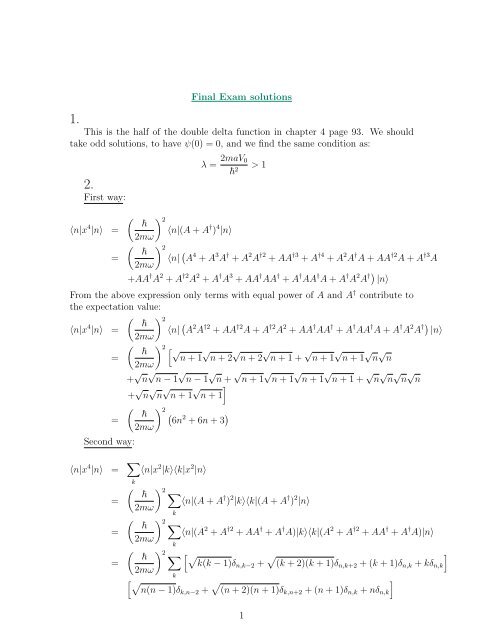Final Exam solutions This is the half of the double delta function in ...
Final Exam solutions This is the half of the double delta function in ...
Final Exam solutions This is the half of the double delta function in ...
- No tags were found...
Create successful ePaper yourself
Turn your PDF publications into a flip-book with our unique Google optimized e-Paper software.
We f<strong>in</strong>d <strong>the</strong> same solution:Third way:〈n|x 4 |n〉 =( ) 2 (6n 2 + 6n + 3 )2mω〈n|x 4 |n〉 =∫dx x 4 |ψ n (x)| 2=( ) 2 ∫ 1 ∞mω 2 n n! √ dy e −y2 y 4 H n (y) 2π −∞We know:yH n = 1 2 H n+1 + nH n−1<strong>the</strong>n,y 2 H n = 1 2 yH n+1 + nyH n−1Now we need,= 1 2 (1 2 H n+2 + (n + 1)H n ) + n( 1 2 H n + (n − 1)H n−2 )= 1 4 H n+2 + 2n + 1 H n + n(n − 1)H n−22∫ ∞−∞dy e −y2 (y 2 H n (y)) 2 ==∫ ∞−∞∫ ∞−∞( 1dy e −y2 4 H n+2 + 2n + 1) 2H n + n(n − 1)H n−22( ( ) 21 2n + 1dy e −y2 16 H2 n+2 +Hn 2 + (n(n − 1)) 2 H 22n−2)where <strong>in</strong> <strong>the</strong> last l<strong>in</strong>e, we have used <strong>the</strong> orthogonality <strong>of</strong> Hermite <strong>function</strong>s.∫ ∞dy e −y2 (y 2 H n (y)) 2 = √ (( ) 212n + 1π−∞16 2(n+2) (n + 2)! +2 n n! + (n(n − 1)) 2 2 (n−2) (n − 2)!)2= √ ( )(n + 2)(n + 1)π2 n (2n + 1)2 n(n − 1)n!+ +44 4which gives us,〈n|x 4 |n〉 =( ) 2 (6n 2 + 6n + 3 )2mω2
Eigenstates:⎛ ⎞⎛ ⎞⎛ ⎞0u 1 = ⎝1⎠ u 2 = √ 1 1⎝0⎠ u 3 = 1 1√ ⎝ 0 ⎠0212−1or eigen<strong>function</strong>s:u 1 (θ, φ) = Y 10 (θ, φ)u 2 (θ, φ) = 1 √2(Y 11 (θ, φ) + Y 1,−1 (θ, φ))u 1 (θ, φ) = 1 √2(Y 11 (θ, φ) − Y 1,−1 (θ, φ))5.First we solve <strong>the</strong> three dimensional harmonic oscillator <strong>in</strong> cartesian coord<strong>in</strong>ates:with <strong>the</strong> follow<strong>in</strong>g energyψ kpq = C kpq H k (x)H p (y)H q (z)e − mω (x2 +y 2 +z 2 )= C kpq H k (x)H p (y)H q (z)e − mωr2E kpq = ω(k + p + q + 3 2 )S<strong>in</strong>ce l = 1 <strong>the</strong> θ and φ dependence should be a comb<strong>in</strong>ation <strong>of</strong> Y 11 (θ, φ), Y 10 (θ, φ)and Y 1,−1 (θ, φ). These spherical harmonics can be obta<strong>in</strong>ed from <strong>the</strong> above wave<strong>function</strong> when <strong>the</strong> degree <strong>of</strong> <strong>the</strong> polynomial part <strong>of</strong> <strong>the</strong> wave <strong>function</strong> <strong>is</strong> one:H 1 (x) ∼ x = r cos φ s<strong>in</strong> θ = − 1 8π2 3 r(Y 11(θ, φ) + Y 1,−1 (θ, φ))H 1 (y) ∼ y = r s<strong>in</strong> φ s<strong>in</strong> θ = − 1 8π2i 3 r(Y 11(θ, φ) − Y 1,−1 (θ, φ))H 1 (z) ∼ z = r cos θ = 4π 3 rY 10(θ, φ)Thus we have three options: (kpq) = (100), (010), (001). So <strong>the</strong> degeneracy <strong>is</strong> 3 and,E 100 = E 010 = E 001 = ω(1 + 3 2 )= 5 2 ωWe can f<strong>in</strong>d <strong>the</strong> wave <strong>function</strong>s as well (unnecessary <strong>in</strong> <strong>the</strong> exam),ψ 100 ∼ (Y 11 (θ, φ) + Y 1,−1 (θ, φ)) r e − mωr2ψ 010 ∼ (Y 11 (θ, φ) − Y 1,−1 (θ, φ)) r e − mωr2ψ 001 ∼ Y 10 (θ, φ) r e − mωr24
6.Mean charge density:ρ(⃗r) = −e|ψ(⃗r)| 2where <strong>in</strong> <strong>the</strong> ground state <strong>of</strong> Hydrogen atom we have,|ψ(⃗r)| 2 = 4 a 3 0e −2r/a 0Gauss Law:∇ 2 ϕ(⃗r) = ρ(⃗r)which gives( ( 1 ∂r 2 ∂ ) )l(l + 1)+ ϕ(⃗r) = −e 4 r 2 ∂r ∂r r 2 a 3 0e −2r/a 0put l = 0, <strong>the</strong>n <strong>the</strong> electric potential ϕ, can be computed by twice <strong>in</strong>tegration as,ϕ(r) = −e 4 ∫ r ∫1 rr 2 e −2r/aa 3 00 r 2= −e 4 ∫ r( )1 −1a 3 0 r 2 4 a 0e −2r/a 0(2r 2 + 2ra 0 + a 2 0) + C( )a20 e −2r/a 0= −e 4 a 3 04r(r + a 0 ) − C rwe take C = a 3 0/4 to have regular solution at orig<strong>in</strong>:ϕ(r) = −e e−2r/a 0a 0 r(r + a 0) + e r<strong>Th<strong>is</strong></strong> <strong>is</strong> <strong>the</strong> potential by electron cloud. We may add <strong>the</strong> proton potential, ϕ p =(+e/r).5








